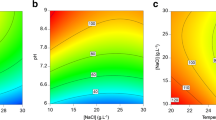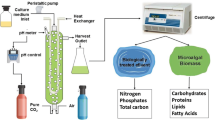Abstract
Night biomass loss due to respiratory activity can significantly impact the phytoplankton biomass productivity and the yield of specific biomolecules. A decrease in biomass loss can be achieved by cyclic two-stage cultivation (CTSC) employing an organic carbon source during the dark phase of the photoperiod. Thus, sugarcane vinasse was used as carbon supply in CTSC to influence the Arthrospira maxima growth. The impact of carbon supply on CTSC was assessed and the results show that splitting the supplementation volume of 60 mL supplemented vinasse into three doses of 20 mL during the dark phase increased biomass productivity by 35.4%, although the maximum exponential growth rate was unaffected. The cyanobacterium also takes up CO2 (supplied in the light phase) as \( {\mathrm{HCO}}_3^{-} \), high concentrations of which increase biomass loss. Thus, carbon assimilation in CTSC is higher when the concentration of dissolved inorganic carbon is reduced. Optimization of organic and inorganic carbon supply in CTSC with the response surface methodology resulted in an increased growth rate (from 0.73 to 1.18–1.62 day−1) and a reduction of cultivation time (from 7 to 5 days), thus producing a synergistic effect of reduced night biomass loss and vinasse treatment. After cultivating A. maxima for 5 days under optimal conditions (culture medium with 6.81 g L−1 of NaHCO3 and adding 1.5% (v/v) vinasse every 4 h during the dark phase), the reduction of chemical oxygen demand and electrical conductivity demonstrates that removal of organic matter present in the vinasse was due to cell growth during CTSC.





Similar content being viewed by others
References
Acién Fernández FG, Fernández Sevilla JM, Molina Grima E (2013) Photobioreactors for the production of microalgae. Rev Environ Sci Biotechnol 12:131–151
Aiba S, Ogawa T (1977) Assessment of growth yield of a blue-green alga, Spirulina platensis, in axenic and continuous culture. J Gen Microbiol 102:179–182
Andrade MR, Camerini FV, Costa JAV (2008) Chemical carbon losses and growth kinetics in Spirulina cultures. Quim Nova 31:2031–2034
Azov Y (1982) Effect of pH on inorganic carbon uptake in algal cultures. Appl Environ Microbiol 43:1300–1306
Barrocal VM, García-Cubero MT, González-Benito G, Coca M (2010) Production of biomass by Spirulina maxima using sugar beet vinasse in growth media. New Biotechnol 27:851–856
Borowitzka MA (2013) High-value products from microalgae—their development and commercialization. J Appl Phycol 25:743–756
Candido C, Lombardi AT (2017) Growth of Chlorella vulgaris in treated conventional and biodigested vinasses. J Appl Phycol 29:45–53
Cavalett O, Junqueira TL, Dias MOS, Jesus CDF, Mantelatto PE, Cunha MP, Franco HCJ, Cardoso TF, Filho RM, Rossell CVE, Bonomi A (2012) Environmental and economic assessment of sugarcane first generation biorefineries in Brazil. Clean Techn Environ Policy 14:399–410
Choi HJ, Lee JM, Lee SM (2013) A novel optical panel photobioreactor for cultivation of microalgae. Water Sci Technol 67:2543–2548
Choix FJ, Ochoa-Becerra MA, Hsieh-Lo M, Mondragón-Cortez P, Méndez-Acosta HO (2018) High biomass production and CO2 fixation from biogas by Chlorella and Scenedesmus microalgae using tequila vinasses as culture medium. J Appl Phycol. https://doi.org/10.1007/s10811-018-1433-2
Chojnacka K, Zielinska A (2012) Evaluation of growth yield of Spirulina (Arthrospira) sp. World J Microbiol Biotechnol 28:437–445
Coca M, Barrocal VM, Lucas S, González-Benito G, García-Cubero MT (2015) Protein production in Spirulina platensis biomass using beet vinasse-supplemented culture media. Food Bioprod Process 94:306–312
Duerr EO, Edralin MR, Price NM (1997) Facilities requirements and procedures for the laboratory and outdoor raceway culture of Spirulina spp. J Mar Biotechnol 5:1–11
Durall C, Lindblad P (2015) Mechanisms of carbon fixation and engineering for increased carbon fixation in cyanobacteria. Algal Res 11:263–270
España-Gamboa E, Mijangos-Cortes J, Barahona-Perez L, Dominguez-Maldonado J, Hernández-Zarate G, Alzate-Gaviria L (2011) Vinasses: characterization and treatments. Waste Manag Res 29:1235–1250
Fernandes BD, Mota A, Ferreira A, Dragone G, Teixeira JA, Vicente AA (2014) Characterization of split cylinder airlift photobioreactors for efficient microalgae cultivation. Chem Eng Sci 117:445–454
Grobbelaar JU, Soeder CJ (1985) Respiration losses in planktonic green algae cultivated in raceway ponds. J Plankton Res 7:497–506
Gupta V, Ratha SK, Sood A, Chaudhary V, Prasanna R (2013) New insights into the biodiversity and applications of cyanobacteria (blue-green algae)—prospects and challenges. Algal Res 2:79–97
Habib MAB, Parvin M, Huntington TC, Hasan MR (2008) A review on culture, production and use of Spirulina as food for humans and feeds for domestic animals and fish, FAO Fisheries and Aquaculture Circular 1034, Rome
Himmelblau DM (1970) Process analysis by statistical methods. Wiley, New York
Jais NM, Mohamed RMSR, Al-Gheethi AA, Amir Hashim MK (2016) The dual roles of phycoremediation of wet market wastewater for nutrients and heavy metals removal and microalgae biomass production. Clean Techn Environ Policy 19:37–52
Keymer PC, Lant PA, Pratt S (2014) Modelling microalgal activity as a function of inorganic carbon concentration: accounting for the impact of pH on the bicarbonate system. J Appl Phycol 26:1343–1350
Kim HW, Marcus AK, Shin JH, Rittmann BE (2011) Advanced control for photoautotrophic growth and CO2-utilization efficiency using a membrane carbonation photobioreactor (MCPBR). Environ Sci Technol 45:5031–5038
Kranert M, Gottschal R, Bruns C, Hafner G (2010) Energy or compost from green waste?—a CO2-based assessment. Waste Manag 30:697–701
Lee E, Jalalizadeh M, Zhang Q (2015) Growth kinetic models for microalgae cultivation: a review. Algal Res 12:497–512
Li J, Stamato M, Velliou E, Jeffryes C, Agathos SN (2015) Design and characterization of a scalable airlift flat panel photobioreactor for microalgae cultivation. J Appl Phycol 27:75–86
Luong JHT (1987) Generalization of Monod kinetics for analysis of growth data with substrate inhibition. Biotechnol Bioeng 29:242–248
Marques SSI, Nascimento IA, Almeida PF, Chinalia FA (2013) Growth of Chlorella vulgaris on sugarcane vinasse: the effect of anaerobic digestion pretreatment. Appl Biochem Biotechnol 171:1933–1943
Morais MG, Costa JAV (2007) Biofixation of carbon dioxide by Spirulina sp. and Scenedesmus obliquus cultivated in a three-stage serial tubular photobioreactor. J Biotechnol 129:439–445
Nitayavardhana S, Issarapayup K, Pavasant P, Khanal SK (2013) Production of protein-rich fungal biomass in an airlift bioreactor using vinasse as substrate. Bioresour Technol 133:301–306
Ogbonna JC, Tanaka H (1996) Night biomass loss and changes in biochemical composition of cells during light/dark cyclic culture of Chlorella pyrenoidosa. J Ferment Bioeng 82:558–564
Ogbonna JC, Tanaka H (1998) Cyclic autotrophic/heterotrophic cultivation of photosynthetic cells: a method of achieving continuous cell growth under light/dark cycles. Bioresour Technol 65:65–72
Olguín EJ (2003) Phycoremediation: key issues for cost-effective nutrient removal processes. Biotechnol Adv 22:81–91
Olguín EJ, Galicia S, Mercado G, Pérez T (2003) Annual productivity of Spirulina (Arthrospira) and nutrient removal in a pig wastewater recycling process under tropical conditions. J Appl Phycol 15:249–257
Ramirez NNV, Farenzena M, Trierweiler JO (2014) Growth of microalgae Scenedesmus sp. in ethanol vinasse. Braz Arch Biol Technol 57:630–635
Rand MC, Greenberg AE, Taras MJ (1976) Standard methods for the examination of water and wastewater, 14th edn. American Public Health Association - American Water Works Association -Water Pollution Control Federation, Washington
Santana H, Cereijo CR, Teles VC, Nascimento RC, Fernandes MS, Brunale P, Campanha RC, Soares IP, Silva FCP, Sabaini PS, Siqueira FG, Brasil BSAF (2017) Microalgae cultivation in sugarcane vinasse: selection, growth and biochemical characterization. Bioresour Technol 228:133–140
Santos RR, Araújo OQF, Medeiros JL, Chaloub RM (2016) Cultivation of Spirulina maxima in medium supplemented with sugarcane vinasse. Bioresour Technol 204:38–48
Subashchandrabose SR, Ramakrishnan B, Megharaj M, Venkateswarlu K, Naidu R (2013) Mixotrophic cyanobacteria and microalgae as distinctive biological agents for organic pollutant degradation. Environ Int 51:59–72
Torzillo G, Sacchi A, Materasi R (1991) Temperature as an important factor affecting productivity and night biomass loss in Spirulina platensis grown outdoors in tubular photobioreactors. Bioresour Technol 38:95–100
Vonshak A, Cheung SM, Chen F (2000) Mixotrophic growth modifies the response of Spirulina (Arthrospira) platensis (Cyanobacteria) cells to light. J Phycol 36:675–679
Wagner I, Steinweg C, Posten C (2016) Mono- and dichromatic LED illumination leads to enhanced growth and energy conversion for high-efficiency cultivation of microalgae for application in space. Biotechnol J 11:1060–1071
Wan M, Zhang J, Hou D, Fan J, Li Y, Huang J, Wang J (2014) The effect of temperature on cell growth and astaxanthin accumulation of Haematococcus pluvialis during a light–dark cyclic cultivation. Bioresour Technol 167:276–283
Wilkie AC, Riedesel KJ, Owens JM (2000) Stillage characterization and anaerobic treatment of ethanol stillage from conventional and cellulosic feedstocks. Biomass Bioenergy 19:63–102
Yu H, Jia S, Dai Y (2009) Growth characteristics of the cyanobacterium Nostoc flagelliforme in photoautotrophic, mixotrophic and heterotrophic cultivation. J Appl Phycol 21:127–133
Zhu CJ, Lee YK (1997) Determination of biomass dry weight of marine microalgae. J Appl Phycol 9:189–194
Acknowledgements
We thank Dr. Mario Giordano for criticisms and helpful suggestions for this manuscript. R. R. dos Santos gratefully acknowledges Gabriela Bouça Marques da Costa for the technical support on the data collected.
Funding
R. R. dos Santos receives a scholarship and financial support from CNPq-Brazil (grant no. 141295/2013-9). J. L. Medeiros and O. Q. F. Araújo receive a research scholarship and financial support from CNPq-Brazil (grant no. 405851/2013-8).
Author information
Authors and Affiliations
Corresponding author
Electronic supplementary material
ESM 1
(DOC 231 kb)
Rights and permissions
About this article
Cite this article
dos Santos, R.R., Chaloub, R.M., de Medeiros, J.L. et al. Enlightening the dark side of Arthrospira maxima cultivation: evaluation of carbon supply modes and performance at optimal growth conditions. J Appl Phycol 31, 9–19 (2019). https://doi.org/10.1007/s10811-018-1578-z
Received:
Revised:
Accepted:
Published:
Issue Date:
DOI: https://doi.org/10.1007/s10811-018-1578-z




